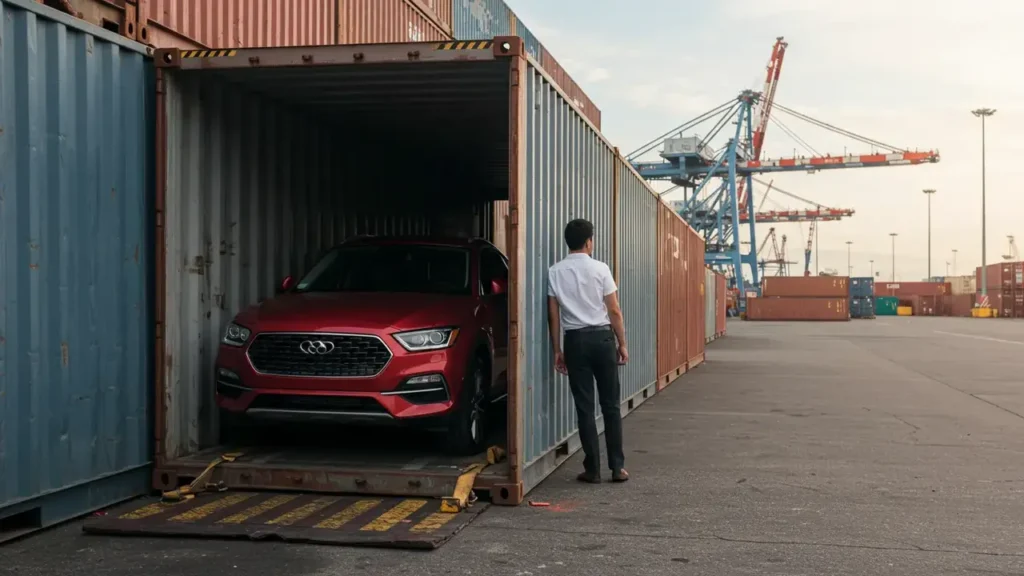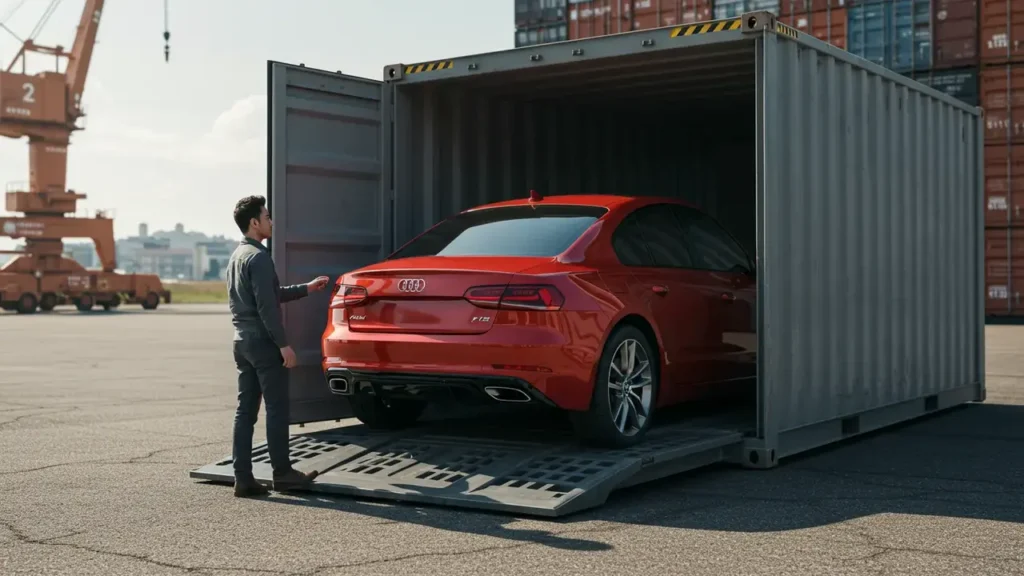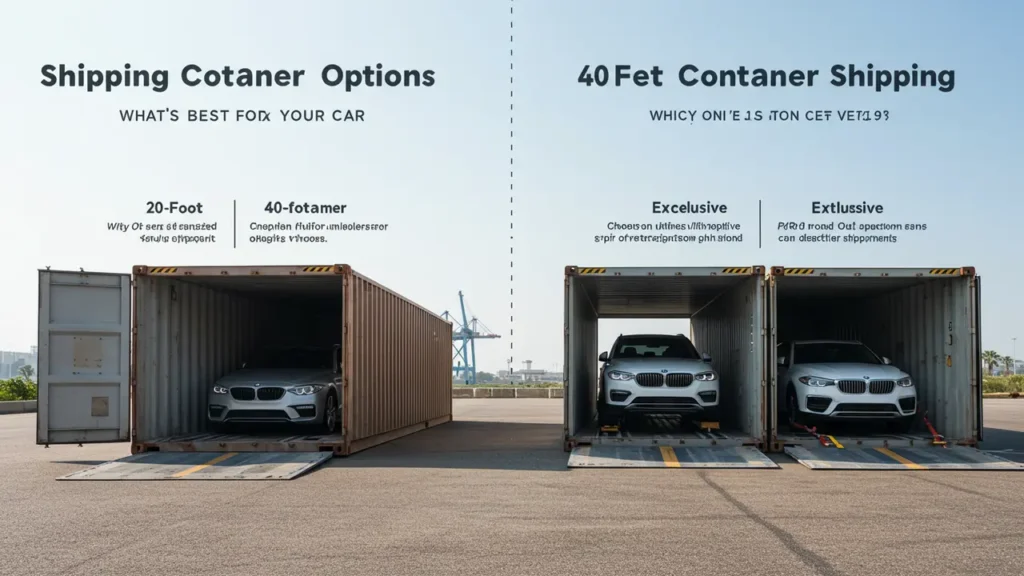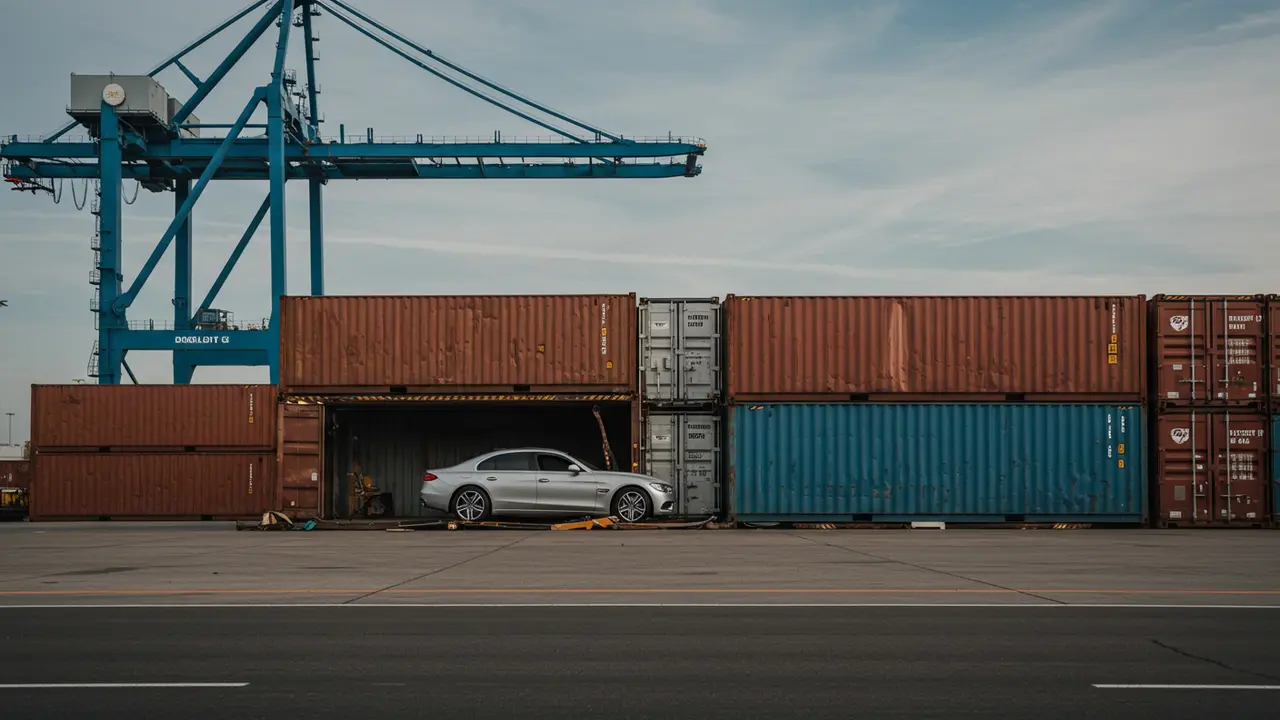Container Car Shipping Costs – Everything You Need to Know
Shipping a car in a container sounds simple, but the cost can surprise you. Some people expect a flat fee, while others think it’s all about the distance. In reality, a bunch of factors come into play, things like container size, port fees, and even the time of year. If you don’t plan right, you might end up paying way more than expected.
So, how much does it actually cost to ship a car in a container? On average, container car shipping costs range from $1,000 to $5,000, depending on the shipping route, type of container, and other expenses. However, prices can go even higher if you’re shipping luxury or oversized vehicles.
This guide will break down everything you need to know, so you don’t get hit with unexpected charges. Let’s get started.

What Is Container Car Shipping?
Shipping a car in a container is one of the safest ways to transport vehicles across long distances, especially for international shipments. Instead of exposing the car to open-air transport, it is securely placed inside a 20-foot or 40-foot shipping container. This method protects the vehicle from weather conditions, theft, and accidental damage during transit.
Overview of Container Car Shipping
Container shipping involves placing a car inside a metal container, which is then loaded onto a cargo ship for transport. This method is commonly used for international car shipping because it offers better security and protection than other options like Roll-on/Roll-off (RoRo) shipping.
The process begins with loading the vehicle into the container. Once inside, the car is either blocked, braced, or strapped down to prevent movement. If it’s a shared container, multiple vehicles may be placed inside to maximize space and reduce costs.
Why Do People Choose Container Shipping for Cars?
Not all car shipping methods are the same, and choosing the right one depends on factors like budget, vehicle type, and destination. Many people prefer container shipping for reasons such as:
- Better Protection: The car is fully enclosed, shielding it from saltwater, rain, and dirt.
- Lower Risk of Damage: Unlike RoRo shipping, where cars are exposed, containers provide extra safety.
- Option to Ship Personal Items: Some shipping companies allow customers to place household items inside the container along with the car.
- Ideal for Luxury or Classic Cars: High-value vehicles require extra care, and containers offer a secure environment during transit.
How Does the Process Work?
The process of container car shipping involves several steps:
- Choosing a Shipping Provider: Customers compare rates from companies like AmeriFreight, Montway Auto Transport, and Easy Auto Ship to find the best service.
- Preparing the Car for Shipment: The car must be cleaned, have a quarter tank of gas, and have no personal belongings inside unless allowed by the shipping company.
- Loading the Car into the Container: It is securely strapped to prevent movement during transport.
- Transportation to the Port: Once secured, the container is taken to the port and loaded onto a ship.
- Customs Clearance: The vehicle undergoes inspections and paperwork processing at both the origin and destination ports.
- Delivery and Unloading: The container arrives at the final destination, where it is unloaded and handed over to the owner.
Container shipping is often the preferred choice for international car transport, offering both security and peace of mind.

How Much Does Container Car Shipping Cost?
The cost of shipping a car in a container isn’t set in stone. Prices depend on several factors, including the shipping distance, container type, and additional fees at both the origin and destination ports. On average, container car shipping costs range between $1,000 and $5,000, but it can go even higher for luxury, oversized, or non-operational vehicles.
Average Cost of Container Car Shipping
For short-distance international routes, like shipping from the U.S. to Canada, costs may be on the lower end, around $1,000 to $2,000. However, shipping from the U.S. to Europe or Asia often falls between $2,500 and $5,000, depending on the container type. If you’re sending a car to Australia or the Middle East, expect to pay anywhere from $3,000 to $6,000, especially when factoring in customs duties and taxes.
Cost Breakdown – What Factors Influence the Price?
The total price of container car shipping isn’t just about the base freight rate. Several elements affect how much you’ll pay.
Shipping Distance plays a major role. The farther the destination, the higher the cost. Transatlantic shipments from the U.S. to Europe will generally cost less than sending a car to Australia or South Africa, simply because of the difference in fuel and transit time.
Vehicle Size and Weight can also impact pricing. A compact sedan will cost less to ship than a full-size SUV or a pickup truck since heavier vehicles require additional handling and may take up more space inside a container.
Type of Container affects the total cost. A shared container is cheaper because multiple cars are placed in the same space, splitting the cost among multiple owners. However, if you prefer an exclusive container, expect to pay a premium.
Port Fees and Customs Duties vary by country and can significantly increase expenses. Some ports charge handling fees, while customs officials in certain regions impose higher import taxes on vehicles. Countries like Brazil and China have stricter import laws, which can drive up costs compared to Europe or Canada, where duties are more predictable.
Insurance Coverage is another factor to consider. While some shipping companies offer basic liability coverage, it may not be enough for high-value or classic cars. Many owners opt for additional insurance, which typically costs between 1% to 3% of the car’s value, adding hundreds of dollars to the total bill.
Fuel Prices and Seasonal Demand can influence shipping rates as well. Shipping during peak seasons, like summer and holiday months, tends to be more expensive due to high demand.
Additional Fees You Should Expect
Beyond the base cost of shipping, there are several extra charges that might appear on your final bill.
Terminal Handling Charges apply when your car is processed at the shipping terminal. These fees cover container movement, crane usage, and labor costs. Depending on the port, they can range from $50 to $500 per shipment.
Documentation and Paperwork Fees are unavoidable. Shipping companies charge for processing customs documents, vehicle titles, and inspection reports. The cost typically falls between $100 to $300, depending on the country’s regulations.
Storage Fees and Late Pickup Costs can also sneak up on you. If the recipient fails to retrieve the car on time, storage fees at the destination port can add up quickly.
Shipping Container Options – What’s Best for Your Car?
Choosing the right container for shipping your car can make a huge difference in cost and safety. The two main options are 20-foot and 40-foot containers.
20-Foot vs. 40-Foot Container – Which One Should You Choose?
A 20-foot container typically fits one standard-sized car, making it a good choice for personal shipments. It’s a more affordable option for single-vehicle transport because you’re paying only for the space you use.
A 40-foot container, on the other hand, can accommodate two to four vehicles, depending on their size. If you’re shipping multiple cars or coordinating with other owners for a shared shipment, this option reduces costs per vehicle.
Shared vs. Exclusive Container – Pros and Cons
A shared container allows multiple cars from different owners to be shipped in the same space. This is a budget-friendly choice since costs are split among all shippers. However, the downside is that your car won’t leave until the container is full, which might delay shipping by days or weeks.
An exclusive container is dedicated solely to your car. It provides faster departure times and better protection, making it ideal for high-value, classic, or luxury vehicles. The trade-off? It’s significantly more expensive since you’re paying for the entire container.

RoRo vs. Container Shipping – Which One Is More Cost-Effective?
Roll-on/Roll-off (RoRo) shipping is another way to transport vehicles, where cars are driven directly onto the ship’s deck and secured. It’s cheaper than container shipping, but the car is exposed to weather, dirt, and potential minor damage.
Container shipping, while pricier, offers more security and protection. It’s the preferred option for fragile, high-end, or customized vehicles that need to arrive in pristine condition.
How to Reduce Container Car Shipping Costs?
Shipping a car in a container isn’t cheap, but there are ways to cut costs without compromising on safety. From booking at the right time to choosing the right shipping method, small decisions can lead to big savings.
Book Early to Lock in Lower Rates
Shipping rates fluctuate based on demand. If you wait until the last minute, you may end up paying higher prices due to limited availability. Booking at least four to six weeks in advance can help secure a better deal.
Compare Multiple Shipping Companies
No two shipping companies charge the same rate. Some specialize in affordable shared container shipping, while others focus on premium enclosed transport. Getting quotes from companies like AmeriFreight, Montway Auto Transport, and uShip can help you find the best deal..
Consider a Shared Container Instead of an Exclusive One
While an exclusive container offers better security and faster shipping, it’s significantly more expensive. A shared container reduces costs by splitting the shipping fee among multiple vehicle owners. If you’re not in a rush, this is a great way to save money.
Ship During Off-Peak Seasons
Demand for international car shipping spikes during summer and holiday months, leading to higher prices. If possible, ship during the fall or early spring when demand is lower. Freight rates often drop by 10% to 20% during these periods, making it easier to find affordable options.
Minimize Additional Fees by Preparing Proper Documentation
Last-minute paperwork mistakes can lead to expensive delays and additional storage fees. Ensure all necessary customs forms, vehicle registration documents, and import permits are ready before the shipping date. Some ports charge extra for incomplete or incorrect paperwork, so double-check everything in advance.
How Long Does Container Car Shipping Take?
The time it takes to ship a car in a container depends on several factors, including the shipping route, customs clearance, and port congestion. On average, international container car shipping takes two to eight weeks, but delays can extend this timeline.
Estimated Shipping Time by Route
For shorter international routes, such as the U.S. to Canada or Mexico, shipping usually takes one to two weeks. Shipping from the U.S. to Europe, including destinations like the UK or Germany, typically ranges from three to five weeks. If you’re sending a car to Australia, the Middle East, or Asia, expect a timeline of four to eight weeks, depending on the port schedules.
Factors That Affect Transit Time
Several factors can influence the overall shipping duration. Port congestion is a major issue, especially in busy shipping hubs like Los Angeles, Rotterdam, and Shanghai, where long wait times for unloading and customs clearance are common. Customs inspections can also cause delays, particularly if there are issues with documentation or compliance.
How to Track Your Car During Transit?
Most shipping companies provide tracking updates via online portals or email notifications. Some offer GPS tracking so you can monitor your car’s exact location in real time. If your carrier doesn’t provide live tracking, you can contact customer service for updates on estimated arrival times.While container shipping offers security and reliability, patience is key..
How to Choose a Reliable Car Shipping Service?
The best way to choose a shipping company is to compare multiple quotes. Don’t just look at the price, pay attention to what’s included in the service. A company that offers low base rates but charges extra for port fees and customs handling may end up being more expensive than one with an all-inclusive package.
Always check customer reviews and ratings before booking. Sites like Trustpilot, Better Business Bureau (BBB), and Google Reviews can give insight into past customer experiences. Look for companies that have clear communication, reliable tracking, and a history of safe deliveries.
Insurance coverage is another key factor. While basic liability coverage is usually included, it may not be enough for luxury or classic cars. Some companies offer full-value protection, but it’s important to ask for the details.
Red Flags to Watch Out for When Hiring a Shipping Company
Not all car shipping companies operate ethically, and there are several red flags to look out for. Be cautious of companies that ask for full payment upfront. Most reputable services require only a deposit, with the remainder paid upon delivery.
Avoid companies with unclear pricing structures. If a quote seems suspiciously low, there’s a good chance that hidden fees will be added later. Also, be wary of pushy sales tactics or companies that refuse to provide written contracts.
Container Car Shipping Regulations & Documentation
Shipping a car internationally isn’t just about loading it into a container and sending it off. Each country has its own set of customs regulations, taxes, and paperwork requirements that must be followed. Failing to meet these requirements can lead to delays, additional fees, or even rejection at the port.
Customs and Import Duties – What You Need to Know
Every country imposes different import duties and taxes on vehicles being shipped. Some countries, like Germany or the Netherlands, have relatively straightforward import processes, while others, like Brazil or China, impose high import taxes and strict compliance rules.
Import duties can range from 5% to over 100% of the car’s value, depending on the country. Some nations have age restrictions on imported vehicles, meaning older cars may not be allowed or could be subject to additional fees. It’s crucial to check destination-specific regulations before shipping to avoid unexpected costs.
Required Documents for Container Car Shipping
Proper documentation is essential for a smooth shipping process. The most commonly required documents include:
- Bill of Lading (BOL): Issued by the shipping company, this serves as a receipt and contract for the shipment.
- Vehicle Title and Registration: Proof of ownership is required to clear customs.
- Export/Import Permits: Some countries require special permits before a vehicle can be shipped or received.
- Photo ID or Passport: The shipper must provide identification matching the vehicle’s title.
- Insurance Documents: If additional insurance is purchased, proof of coverage may be required at customs.
Conclusion
Container car shipping is one of the safest and most secure ways to transport a vehicle internationally, but it comes at a cost. Prices vary based on distance, container type, customs fees, and seasonal demand, with costs ranging from $1,000 to $5,000 or more. Choosing the right shipping company, booking early, and opting for a shared container can help reduce expenses.






